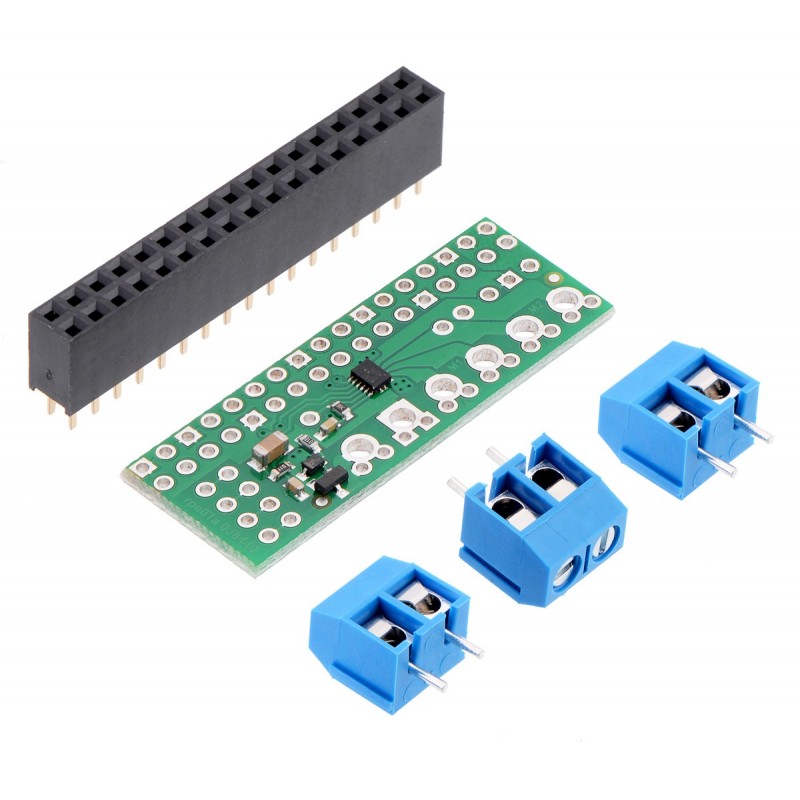











zł46.10 tax excl.
This compact expansion board plugs directly into the GPIO header on a Raspberry Pi B+, A+, or Pi 2 and provides an easy and low-cost solution for driving a pair of small brushed DC motors. Pololu 2753
Pololu - 2753
This compact expansion board plugs directly into the GPIO header on a Raspberry Pi B+, A+, or Pi 2 and provides an easy and low-cost solution for driving a pair of small brushed DC motors. Its integrated DRV8835 dual motor driver allows it to operate from 1.5 V to 11 V, making it a great control option for low-voltage motors. The board can deliver a continuous 1.2 A (1.5 A peak) per motor, or a continuous 2.4 A (3 A peak) to a single motor when configured with both channels connected in parallel.
DESCRIPTION
Overview
This motor driver kit and its corresponding Python library make it easy to control a pair of bidirectional, brushed DC motors with a Raspberry Pi Model B+, A+, or Pi 2. The expansion board features Texas Instruments’ DRV8835 dual H-bridge motor driver IC, which allows it to operate from 1.5 V to 11 V and makes it particularly well suited for driving small, low-voltage motors.

The board can deliver a continuous 1.2 A per channel and tolerate peak currents up to 1.5 A per channel for a few seconds, and the channels can be optionally configured to run in parallel to deliver twice the current to a single motor. The board ships fully populated with its SMD components, including the DRV8835 driver and a FET for reverse battery protection; header pins for interfacing with a Raspberry Pi and terminal blocks for connecting motors and power are included but are not soldered in (see the Assembly with included hardware section below).
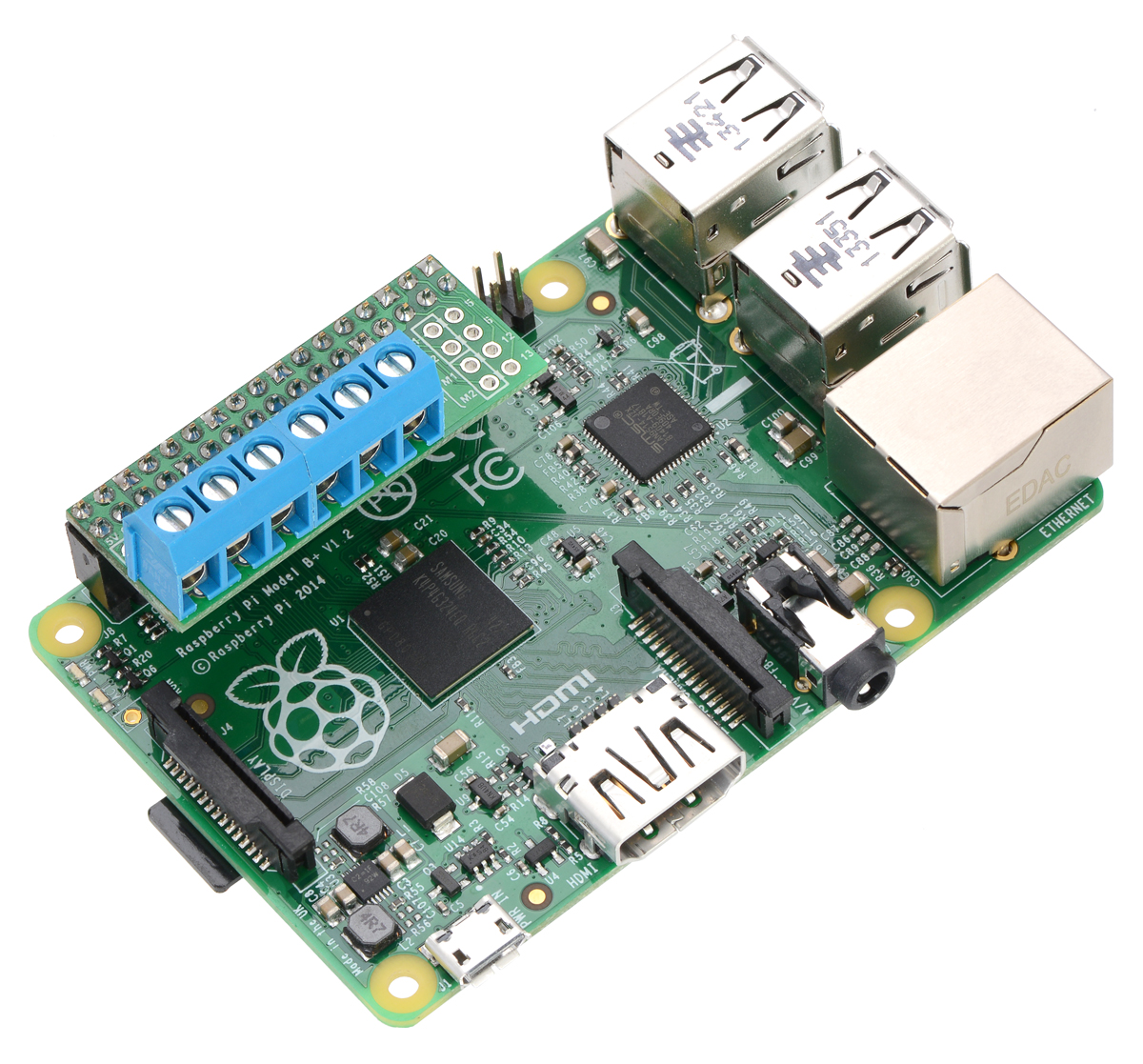
The board uses GPIO pins 5, 6, 12, and 13 to control the motor driver, making use of the Raspberry Pi’s hardware PWM outputs, although the pin mappings can be customized if the defaults are not convenient. Note that it is designed specifically for newer versions of the Raspberry Pi with 40-pin GPIO headers, including the Model B+, Model A+, and Raspberry Pi 2 Model B; it is not practical to use this expansion board with the original Raspberry Pi Model A or Model B due to differences in their pinout and form factor.
We also have a similar DRV8835 shield for Arduinos and Arduino-compatible boards and a smaller DRV8835 carrier for those using a different controller or with tighter space constraints. For a more powerful motor driver, consider the dual MC33926 motor driver for Raspberry Pi.
Features

Pololu DRV8835 dual motor driver board
for Raspberry Pi, top and bottom sides.
Assembly with included hardware
Before the motor driver board can be plugged into your Raspberry Pi, female headers must be soldered into the appropriate holes. The kit ships with a 2×17-pin 0.1″ female header that should be mounted to the bottom of the board (the side with surface-mount components). Once the kit is assembled, it should be plugged into the leftmost position on the Raspberry Pi’s 40-pin GPIO header, leaving six pins exposed on the right, as shown in the picture below.
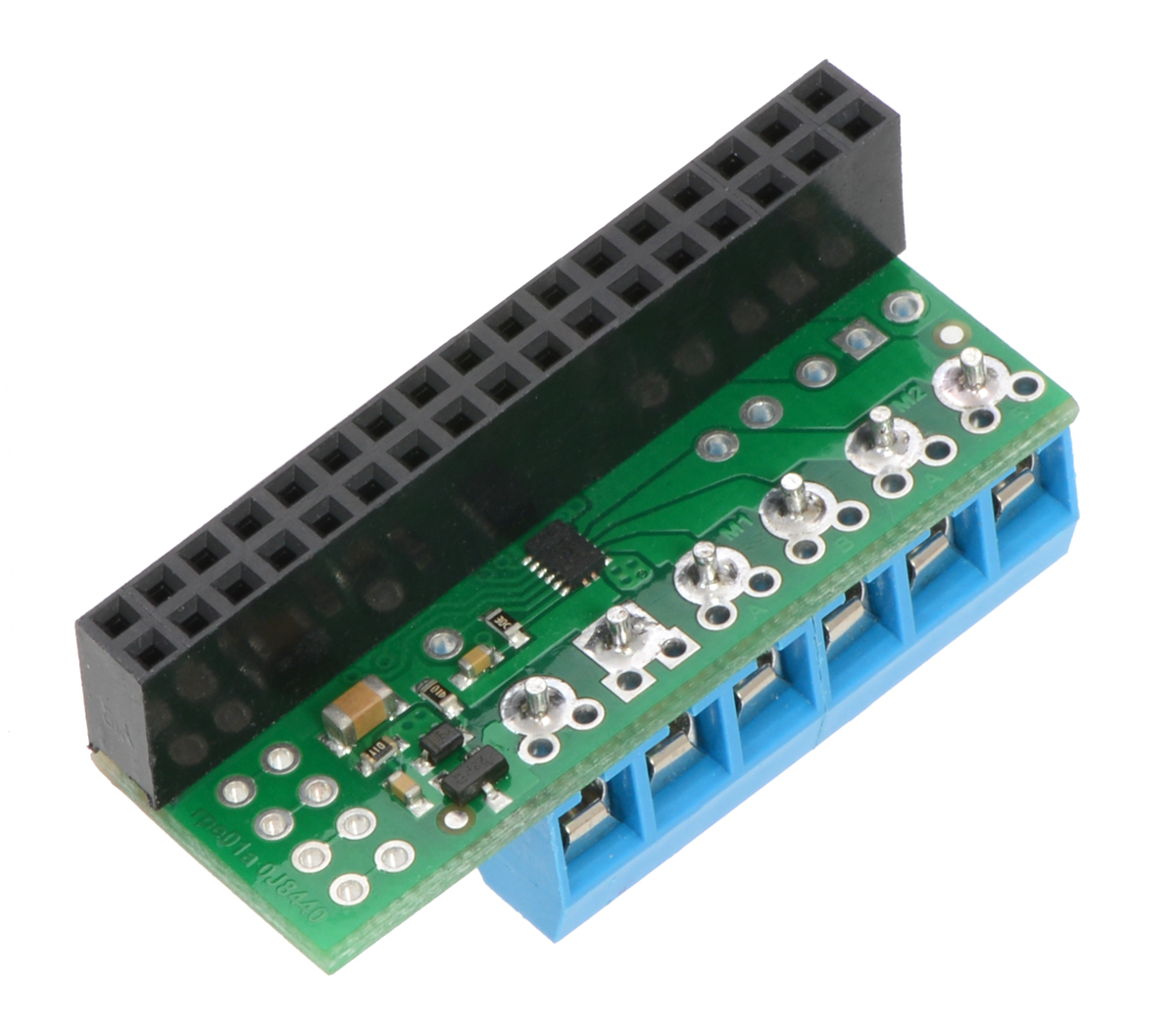
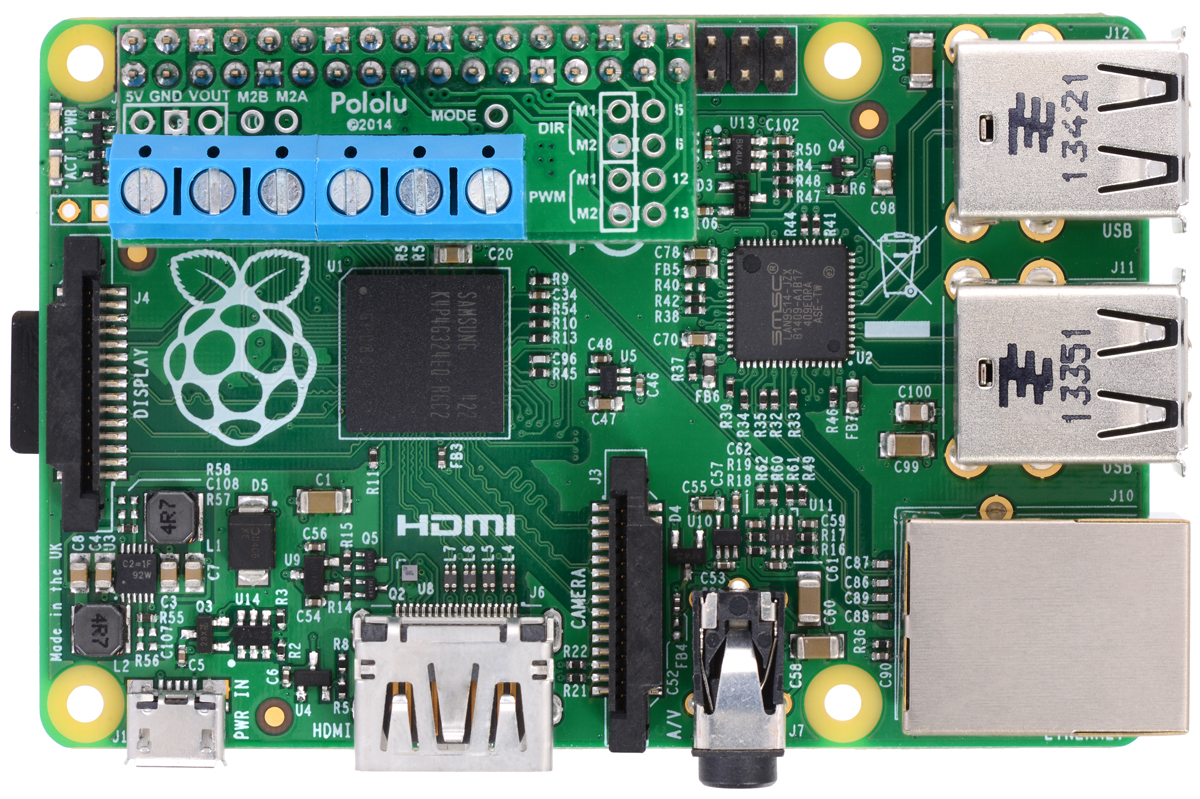
Three 2-pin, 5 mm terminal blocks are included for making easy motor and power connections to the board once they have been slid together and soldered to the six large through-holes. Alternatively, you can solder 0.1″ male header pins to the smaller through-holes above the terminal block holes, or you can just solder wires directly to the board.
Shorting blocks and 0.1″ male headers (not included) can be used to make some of the more advanced optional modifications to the board, such as remapping the control pins or paralleling the outputs.
A Raspberry Pi is not included.

Driving motors with an assembled Pololu DRV8835 Dual Motor Driver Kit on a Raspberry Pi B+.
A step-up/step-down regulator provides 5 V to the Raspberry Pi.
Using the motor driver
In the board’s default state, the motor driver and Raspberry Pi are powered separately, though they share a common ground and the DRV8835 receives its logic supply voltage (VCC) from one of the Raspberry Pi’s 3V3 power pins. When used this way, the Raspberry Pi must be powered via its USB Micro-B receptacle, and the motor driver board must be supplied with 1.5 V to 11 V through its large VIN and GND pads. However, the motor driver board provides a set of three through-holes where you can conveniently connect an appropriate voltage regulator, allowing the motor supply to also power the Raspberry Pi (see the Powering the Raspberry Pi from the motor driver board section below).
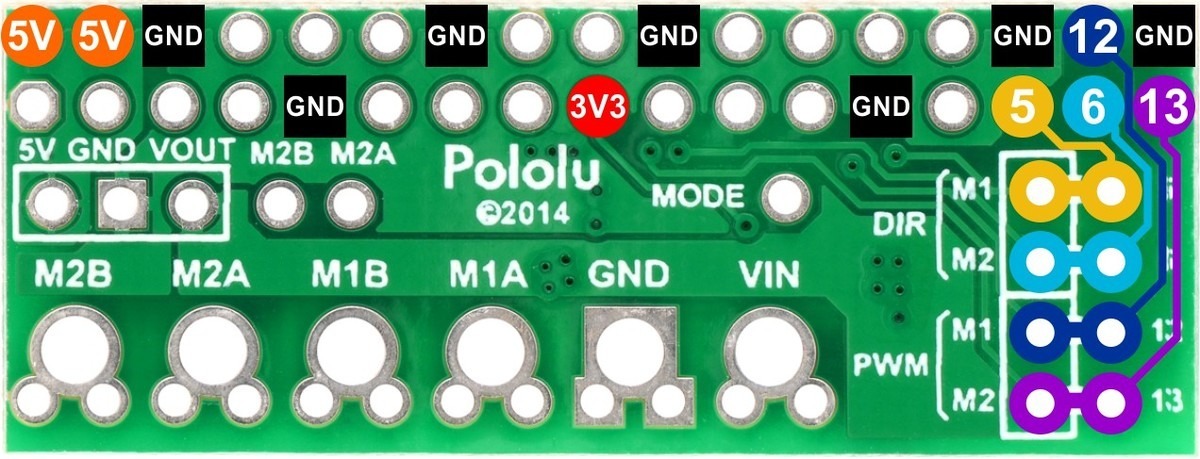
By default, the driver is configured to operate in PHASE/ENABLE mode, in which a PWM signal applied to the ENABLE pin determines motor speed and the digital state of the PHASE pin determines direction of motor rotation. GPIO 12 and 5 are used to control the speed and direction, respectively, of motor 1, and GPIO 13 and 6 control the speed and direction of motor 2. The table below shows how the inputs affect the outputs in this mode:
| Drive/brake operation in default PHASE/ENABLE mode | ||||
|---|---|---|---|---|
| xPHASE | xENABLE | MxA | MxB | operating mode |
| 1 | PWM | L | PWM | reverse/brake at speed PWM % |
| 0 | PWM | PWM | L | forward/brake at speed PWM % |
| X | 0 | L | L | brake low (outputs shorted to ground) |
PHASE/ENABLE mode should be suitable for most applications.
Configuring the board for IN/IN mode
The operating mode of the driver is controlled by the MODE pin, which the board pulls high to VCC through a 20 kΩ resistor to select PHASE/ENABLE mode by default. The pin labeled “MODE” can be driven low (or connected directly to ground) to switch the control interface to IN/IN, which allows for slightly more advanced control options as described in the table below:
| Drive/coast or drive/brake operation with MODE=0 (IN/IN) | ||||
|---|---|---|---|---|
| xIN1 | xIN2 | MxA | MxB | operating mode |
| 0 | 0 | OPEN | OPEN | coast (outputs off) |
| 0 | PWM | L | PWM | reverse/coast at speed PWM % |
| PWM | 0 | PWM | L | forward/coast at speed PWM % |
| PWM | 1 | L | PWM | reverse/brake at speed 100% − PWM % |
| 1 | PWM | PWM | L | forward/brake at speed 100% − PWM % |
| 1 | 1 | L | L | brake low (outputs shorted to ground) |
Configuring the board for single-channel mode (parallel outputs)
In order to use the two motor channels in parallel to control a single motor, it is important to ensure that both channels will always receive the same control signals, so the reconfiguration process begins with a modification to the control inputs. First, locate the 2×4 grouping of 0.1″ through-holes along the right side of the board. The traces on the underside of the PCB between each pair of holes effectively link the Raspberry Pi’s GPIO pins to the DRV8835 control pins. If you want to remap one of these control pins, you can cut the desired trace with a knife and then run a wire from the inner hole to a new GPIO pin. The remapping for single-channel mode requires you cut one PWM (12 or 13) and one DIR (5 or 6) trace. If you then solder a row of header pins along the interior row of holes, you can safely connect both PWM lines together and both DIR lines together using shorting blocks. In this configuration, the two uncut Raspberry Pi control lines determine the behavior of both motor channels.
The last step is to connect the output channels together. An easy way to do this is to solder wires to the two small holes labeled “M2A” and “M2B” above the motor outputs. You can then connect the M2A wire to the large M1A output pad and the M2B wire to the large M1B output pad, which in turn means you can get up to 3 A from the connection points for M2 (you can have your motor connected just to the M2A and M2B terminal blocks rather than trying to find a way to connect it to all four motor outputs).
Powering the Raspberry Pi from the motor driver board
On the left side of the expansion board is a set of three pins surrounded by a box and labeled “5V”, “GND”, and “VOUT”. The “5V” pin is connected to the Raspberry Pi’s 5V power rail, while the VOUT pin provides access to the driver board’s motor supply voltage after reverse-voltage protection. If a suitable voltage regulator is connected to these three pins, it can generate 5 V to power the Raspberry Pi from the board’s motor supply voltage. We suggest using our S7V7F5 switching step-up/step-down regulator, which has a 2.7 V to 11.8 V input voltage range (similar to that of the DRV8835) and can supply up to 1 A of current to the Raspberry Pi.
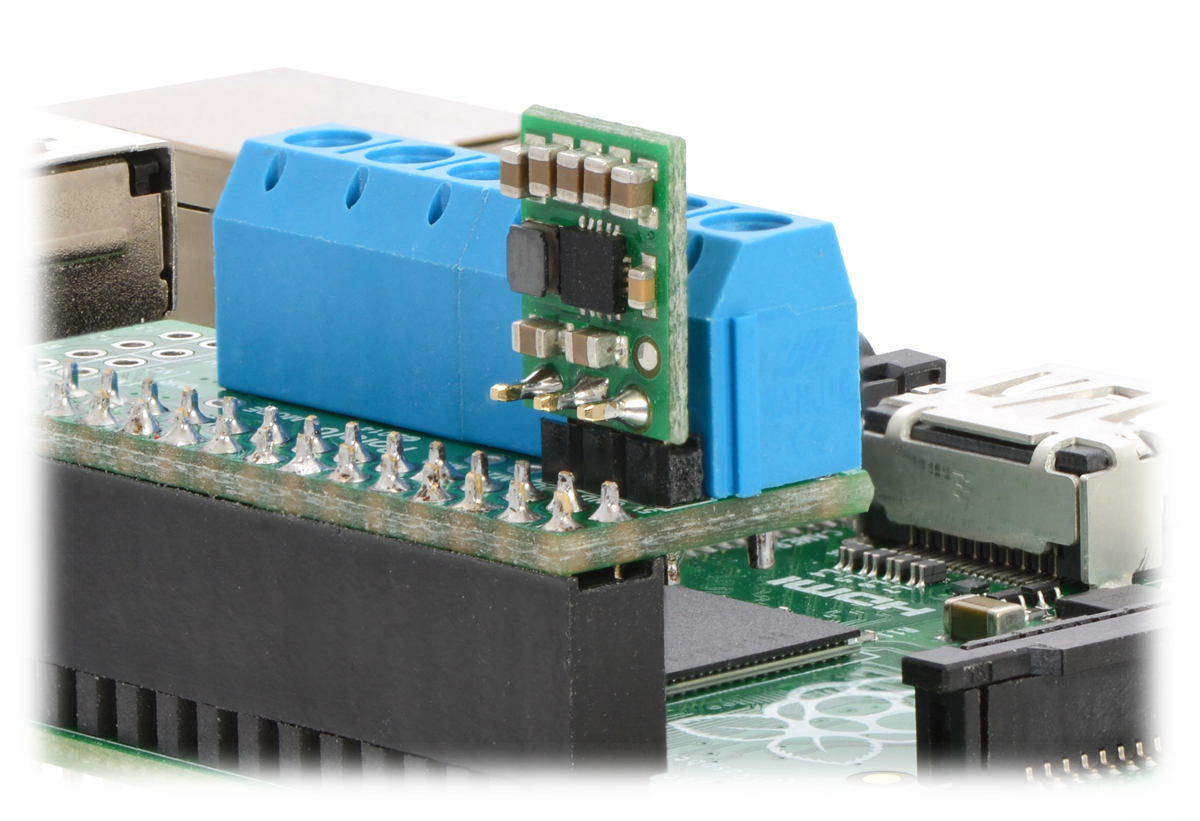
S7V7F5 step-up/step-down regulator connected to an assembled
Pololu DRV8835 Dual Motor Driver Kit for Raspberry Pi.
When adding a voltage regulator to the motor driver board, take care to orient it correctly: note that the motor driver board’s VOUT pin should connect to the regulator’s VIN pin, while the regulator’s VOUT pin should connect to the motor driver board’s 5V pin.
There are several considerations to keep in mind when powering the Raspberry Pi through a voltage regulator in this way:
Real-world power dissipation considerations
The DRV8835 datasheet recommends a maximum continuous current of 1.5 A per motor channel. However, the chip by itself will overheat at lower currents. For example, in our tests at room temperature with no forced air flow, the chip was able to deliver 1.5 A per channel for approximately 15 seconds before the chip’s thermal protection kicked in and disabled the motor outputs, while a continuous current of 1.2 A per channel was sustainable for many minutes without triggering a thermal shutdown. The actual current you can deliver will depend on how well you can keep the motor driver cool. Our tests were conducted at 100% duty cycle; PWMing the motor will introduce additional heating proportional to the frequency.
This product can get hot enough to burn you long before the chip overheats. Take care when handling this product and other components connected to it.
SPECIFICATIONS
Dimensions
| Size: | 1.7″ × 0.65″1 |
|---|---|
| Weight: | 2.3 g1 |
General specifications
| Motor driver: | DRV8835 |
|---|---|
| Motor channels: | 2 |
| Minimum operating voltage: | 1.5 V2 |
| Maximum operating voltage: | 11 V |
| Continuous output current per channel: | 1.2 A3 |
| Peak output current per channel: | 1.5 A |
| Continuous paralleled output current: | 2.4 A3 |
| Maximum PWM frequency: | 250 kHz |
| Reverse voltage protection?: | YES |
Notes:
1. Without included hardware.
2. The DRV8835 itself has a minimum motor supply voltage of 0 V, but the boards reverse-voltage protection circuit limits the minimum to 1.5 V.
3. Typical results with 100% duty cycle at room temperature.
RESOURCES
File downloads
Recommended links
Manufacturer BTC Korporacja sp. z o. o. Lwowska 5 05-120 Legionowo Poland sprzedaz@kamami.pl 22 767 36 20
Responsible person BTC Korporacja sp. z o. o. Lwowska 5 05-120 Legionowo Poland sprzedaz@kamami.pl 22 767 36 20
100:1 Micro Metal Gearmotor HP
No product available!
Pololu 5V Step-Up/Step-Down Voltage Regulator S7V7F5
Raspberry Pi 3 model B (Quad Core Broadcom BCM2837, 4x1.2GHz ARM Cortex-A53, RAM 1GB, 4xUSB, Ethernet, HDMI, Wifi, Bluetooth)
No product available!
Miniature high-power motor from the Pololu MP series. Gear motor 5: 1,
the rotational speed of the shaft is 4400 rpm, the torque is 0.1 kg * cm (0.01 Nm).
The motor has an extended shaft which makes it easy to attach the encoder. Pololu 2376
No product available!
Miniature high-power motor from the Pololu MP series. Gear motor 250: 1, shaft speed is 90 rpm, torque is 3 kg * cm (0.3 Nm). The motor has an extended shaft which makes it easy to attach the encoder. Pololu 2384
The Raspberry Pi 3 Model B+ is boasting a 64-bit quad core processor BCM2837B0 running at 1.4GHz, dual-band 2.4GHz and 5GHz wireless LAN, Bluetooth 4.2/BLE, faster Ethernet, and PoE capability via a separate PoE HAT
Adafruit 16-Channel PWM / Servo HAT for Raspberry Pi - Mini Kit (Adafruit 2327)
HAT module with TB6612FNG motor driver and PCA9685 PWM driver designed for Raspberry Pi minicomputers. The board is equipped with a 40-pin connector. Adafruit 4280
DC motor driver that allows you to control the movement of two drives using the I2C interface. Board with soldered connectors. Pololu 5057
No product available!
DC motor driver that allows you to control the movement of three drives using the I2C interface. Pololu 5035
Module with 16-channel PCA9685 servo driver designed for Raspberry Pi minicomputers. The board is equipped with a USB Type C power connector. SparkFun DEV-15316
DC motor driver that allows you to control the movement of two drives using the I2C interface. Board without connectors. Pololu 5056
No product available!
DC motor driver that allows you to control the movement of two drives using the I2C interface. Board with connectors for assembly. Pololu 5058
No product available!
Pololu Dual G2 High-Power Motor Driver 24v18 is an extension that allows you to control two DC motors designed for Raspberry Pi. The motors can be supplied with 6.5-36V voltage and can draw a maximum current of 18A. Pololu 3756
No product available!
DFRobot 0592 is a Raspberry Pi DC motor driver board with built-in encoder interface that can drive a 2-way DC motor and a DC motor with encoder
Module with a 2-channel driver for DC motors TB6612FNG designed to work with the Raspberry Pi. It can work with voltages from 6 to 12 V and currents up to 3 A. SB Components 21468
DC motor driver that allows you to control the movement of two drives using the I2C interface. Board with connectors for assembly. Pololu 5055
No product available!
DC motor driver that allows you to control the movement of two drives using the I2C interface. Board with soldered connectors. Pololu 5048
No product available!
This add-on board makes it easy to control two high-power DC motors with a Raspberry Pi. Its twin discrete MOSFET H-bridges support a wide 6.5 V to 30 Voperating range and are efficient enough to deliver a continuous 18 A without a heat sink. The drivers offer basic current limiting functionality, and they accept ultrasonic PWM frequencies for quieter operation.
No product available!
DC motor driver that allows you to control the movement of two drives using the I2C interface. Board with soldered connectors. Pololu 5051
No product available!
DC motor controller that allows the movement of three drives to be controlled via an I2C interface. Kit with connectors for self-assembly. Pololu 5072
This programmable module combines with a Raspberry Pi to serve as the control center of a small robot or electronics project. Its Atmel ATmega32U4 microcontroller comes preloaded with an Arduino-compatible bootloader, and the board includes dual motor drivers that can deliver 1.8 A per channel to two brushed DC motors.

This compact expansion board plugs directly into the GPIO header on a Raspberry Pi B+, A+, or Pi 2 and provides an easy and low-cost solution for driving a pair of small brushed DC motors. Pololu 2753
